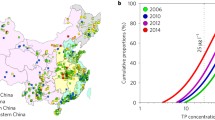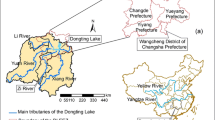Abstract
Taihu Lake is located at the densely populated region of the eastern coast of China. Taihu Basin is one of the most developed regions of China. Over the past decades, especially since the reforming and opening-up of China in 1980s, the lake has received more and more pressure from a variety of interlinked human activities, including industrial pollution, fertilizer and pesticide application, eutrophication, overfishing, etc. Water quality has been deteriorating sharply in the lake. In this paper, we made a comprehensive assessment of the environmental and socio-economic issues to affect Taihu Lake ecosystem health. Pollution was identified as the most serious environmental concern. The root causes of these environmental problems are recognized to be diverse, including dense population, high urbanization, heavy industrialization, fast economic development, insufficient sewage treatment, weak public awareness of environment conservation, and lack of institutional capacity and insufficient enforcement through regulations and legislation. On the policy part, past and current policies and measures are reviewed, especially the “Zero” discharge action and phosphate ban in detergents in Taihu Basin. In order to mitigate environmental problems, some further policy options have been proposed, including: improving the fishery management; strengthening cross- provincial collaboration; making efforts to reduce flood disaster and increasing investment to new environmental protection technologies. It is important to assess the economic, social and environmental values of natural resources (soil, water and organisms) in order to allocate them efficiently and fairly between the present and future generations.
Similar content being viewed by others
References
Belausteguigoitia J C (2004). Causal Chain Analysis and Root Causes: The GIWA Approach. Ambio, 33: 1–2
Duda A M (2003). Integrated management of land and water resources based on a collective approach to fragmented international conventions. Phil Trans R Soc Lond, 358: 2051–2062
Fan C X, Ji J, Chen H S (1997). The current eutrophication status and trend of Lake Taihu and its comprehensive control countermeasure. Shanghai Environment Science, 16(8): 4 (in Chinese with English abstract)
Gao J F, Mao X W (2002). Economic development and its impact to flood disaster in Taihu Basin. Journal of Lake Science, 14(1): 47–52 (in Chinese with English abstract)
Hu B B (2003). Analysis on effect of water pollution in Lake Taihu Basin on water quality of Lake Taihu. Shanghai Environment Science, 22(12): 1017–1021 (in Chinese)
Huang W Y, Yang G S, Xu P Z (2002). Environmental Effect of “Zero” Actions in Taihu Basin. Journal of Lake Science, 14(1): 67–71 (in Chinese with English abstract)
Liang W, Jia Q F, Hua Y J (2001). Influence of alga contamination on the quality of drinking water in the Taihu area. Jiangsu Prev Med, 12(1): 1–2 (in Chinese)
Lin Z X (2002). Analysis of water environmental change in Taihu watershed. Journal of Lake Science, 14(2): 111–116 (in Chinese with English abstract)
Liu H Z, Ren L J, Hu M (1998). The countermeasures in Tai-lake pollution control. Science of Environment Protection, 24(6): 5 (in Chinese with English abstract)
Qin W, Liang S R, Jia W F (1997). Dynamic and increment measures of Salangidae population. Fresh Fisheries, 27(6): 3–6 (in Chinese)
SEPA (2005a). State Environmental Protection Administration of China. The restircted standard data of municipal wastewater treatment plant runoff retrived, september 23 2005 (in Chinese)
SEPA (2005b). State Environmental Protection Administration of China. The regulations and laws about water pollution fines can been found in (in Chinese)
Shi J H, Wang H (1997). Countermeasure about eutrophication in Taihu Lake. Protect Water Resources, 12: 12–15 (in Chinese with Englishabstract)
Shu J H, Huang W Y, Gao G, Zhou X W, Jiang Y C (2002). Effect of phosphate banned in detergents in Taihu region. Detergent & Cosmetics, 25(2): 26–28 (in Chinese)
Qu J, Xu Z, Long Q, Wang L, Shen X, Zhang J, Cai Y (2005). East China Sea, GIWA Regional assessment 36. Kalmar: Kalmar University Press
Wang X J, Ma T (2001). Application of remote sensing techniques in monitoring and assessing the water quality of Taihu Lake. Bull Environ Contam Toxicol, 67: 863–870 (in Chinese with English abstract)
Xie H B, Chen W (2002). Impacts of change of structure on the water environment in Taihu Basin: A case study of Suzhou-Wuxi-Changzhou district. Journal of Lake Science, 14(1): 53–59 (in Chinese with English abstract)
Yang G S, Wang D J (2003). Taihu Basin, Economic Development · Water Environment · Water disaster. Beijing: Science Press (in Chinese)
Yao S M, Zhu M, Chen Z G (2001). Cities in China. Heifei: Chinese Scientic College Press, China (in Chinese)
Yu J, Yang J (2001). National efforts to tackle pollution in Taihu Lake. China Environment News. Site accessed 24th May 2001 (in Chinese)
Author information
Authors and Affiliations
Corresponding author
Rights and permissions
About this article
Cite this article
Wang, L., Cai, Y. & Fang, L. Pollution in Taihu Lake China: causal chain and policy options analyses. Front. Earth Sci. China 3, 437–444 (2009). https://doi.org/10.1007/s11707-009-0043-3
Received:
Accepted:
Published:
Issue Date:
DOI: https://doi.org/10.1007/s11707-009-0043-3




